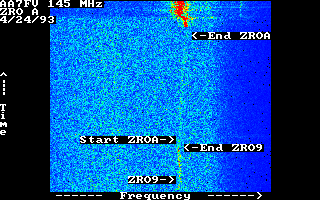
by Darrel Emerson, AA7FV and G3SYS. QEX, (published by ARRL) January 1994, p.17-24. Also appeared in the proceedings of the 11th AMSAT-NA Annual Meeting and Space Symposium, 1993, p.144. (published by ARRL).
(Copyright on the original article is held by the ARRL)
This article describes the use of digital signal processing to pull the AMSAT AO-13 ZRO test signal out of the noise. In the ZRO tests, a signal is transmitted from the Oscar 13 satellite at progressively lower power levels, in 3 dB steps. The challenge is to decode successfully the weakest possible signal. The signal from the receiver audio was digitized using a Sound Blaster card, then filtered with a modified FFT routine. The modification was to allow the pre-detection filter to follow the slowly drifting signal. After using the matched, sliding filter before detection, the post-detection signal was passed through another matched filter. Finally, a cross-correlation technique comparing the detected, filtered signal with every possible combination of ZRO signal was applied, taking also into account a gradual drift of CW sending speed. The final, statistically most probable, solution turned out to be correct. This gave the only successful detection of level A transmissions from Oscar 13 so far (Aug 1996.) The extensive digital processing partly made up for the relatively poor receiving antenna; a 10-element 146 MHz Yagi, part of the Cushcraft AOP-1 combination.

The false colour image above shows the frequency spectrum against time, during 100 seconds including the end of the ZRO9 and the entire ZROA test. Time increases from bottom to top, and frequency, left to right, covers a range of 400 Hz. Each pixel represents a half-second of data, with a frequency resolution of 2 Hz. A combination of changing Doppler shift, receiver and transmitter drift causes the signal to drift a few tens of Hz to the right of the plot during the transmission.
For a full account, please consult the original article, either in the January 1994 issue of QEX (published by the ARRL) or in the Procceedings of the 11th AMSAT Annual Meeting and Space Symposium (available from AMSAT).